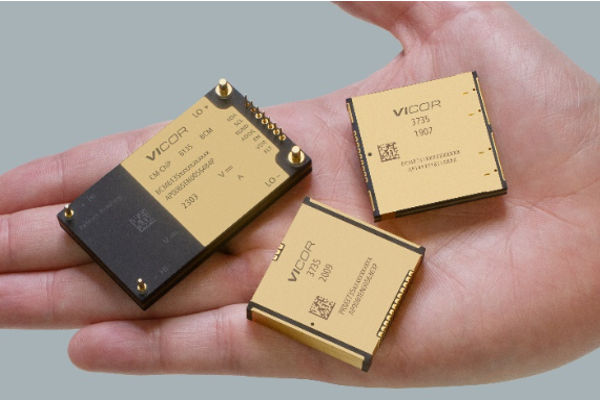In order to enable automotive OEM and tier one production in 2025, three new automotive-grade Vicor power modules for 48V EV systems. The new Vicor Power Modules offer an industry-leading power density. The AEC-Q100 certified Vicor-designed ICs used by the BCM6135, DCM3735, and PRM3735 have successfully finished the PPAP process with automotive customers.
By converting 800V from the traction battery to 48V, the BCM6135, a 98% efficient 2.5kW BCM bus converter, gives the vehicle a safety extra-low voltage (SELV) power source. By providing internal isolation between high and low voltage, the BCM6135 significantly reduces the amount of space needed for DC-DC conversion.
EV system designers may lower the size of the primary DC-DC converter and vehicle weight thanks to the BCM6135’s power density of 158kW/L.
By acting as a virtual 48V battery in the xEV car and providing significant weight and cost savings, the BCM6135 can replace a 25 lb 48V battery thanks to its bidirectional rapid current transient response rate of 8 mega amps per second.
An unregulated 48V input is converted to a regulated 12V output by the DCM3735 2.0kW DCM™ DC-DC converter. Because the output can be trimmed between 8 and 16V, the DCM3735’s broad input range makes it suitable for a multitude of automotive applications. With a power density of 300kW/L, the DCM3735 is a desirable option for designs that connect a 48V distribution to 12V subsystems in zonal ECU applications.
The PRM3735 is a 99.2% efficient 2.5kW PRM™ regulator for 48V electricity. The DC-DC power supply’s overall volume and weight are decreased, and packing space is freed up by its compact size and 260kW/L power density. Supporting regulated 48V loads, which are used in contemporary car architectures, is its strongest suit.
With more than 300 possible combinations, the recently launched Vicor power modules provide exceptional flexibility and scalability to facilitate innovation for a range of vehicle subsystems.
Moreover, these components are very effective in converting to and from 48V, which is important as the market moves from 12V to 48V Zonal Architecture. All three modules have automatic power sharing for optimal array performance and are easily arrayable to boost power supply levels. These modules work with 800V, 400V, 48V, and 12V systems to address complicated problems.
Vicor power modules are improving power delivery networks throughout the vehicle in innovative ways:
- Active suspension comes of age in EVs
Power needs of active suspension system are too high to be met with 12V power. Switching to a 48V bus and converting down with the bidirectional BCM6135 is an efficient way to deliver high performance. This application also capitalizes on the BCM6135’s high slew rate as the active suspension is a regenerative power load, which requires immediate current flow reversal to pass regenerated power back to the battery.
- Deleting or reducing the low-voltage battery
The industry-leading slew rate of the BCM6135 presents an opportunity to replace a 48V battery — with the BCM serving as a virtual 48V battery in the xEV vehicle, delivering cost and weight savings. Since the BCM6135 can switch from zero current to full current at 8.0MA/s, it can step down the traction battery’s 800 to 48V and power a load as fast as drawing the power from an auxiliary 48V battery. No other DC-DC converter can match this speed and enables customers to reduce vehicle weight by up to 25kg while reducing vehicle costs by up to $100.
- 48V zonal architecture adoption is on every roadmap
The new power modules can be easily configured to make this transition easier. The DCM3735 is used in conjunction with BCM3735 to create a regulated 12V power supply off the BCM6135 48V output. When used as a part of the 48V zonal architecture, the DCM3735 can be mounted remotely to create a local 12V supply in a vehicle zone, for example on the right hand side. This application method allows the PDN designer to effectively support 12V loads while achieving up to 90% of the cost and weight savings that come from transitioning to a 48V bus.
- Precharging prevents current surges and saves weight
Precharging is a necessary step of the start-up process. It prevents current surges at battery engagement that will damage the loads (such as pumps and compressors). Currently this is done using high voltage contactors and resistors, which add 1kg and over $50 in cost. The alternative is to use BCM6135 and a PRM3735 as the main DC-DC converters and one of the low-voltage batteries installed in the vehicle. The BCM6135 can boost the low-voltage battery power up to high voltage and achieve the needed precharge, eliminating the legacy precharge contactor and power resistor.
The Vicor power modules versatility makes it possible to power a wide range of automotive applications. They fulfill the promise of 48V adoption, which is more significant. Vicor’s high performance, automotive grade power modules provide the highest power density while lowering power loss and streamlining designs, whether they are used to convert a high voltage traction battery to 48V, deliver point-of-load power from a 48V bus, or allow legacy 12V sub-systems to operate in new 48V zonal architectures.
Key Comments
“Vicor has set a new standard for power density in the automotive industry with these scalable and flexible miniature Vicor power modules,” said Patrick Wadden, VP of the Vicor Automotive business unit. “Our high-performance converters enable new possibilities for automotive manufacturers to reduce the size and weight of power systems throughout the vehicle.”
“Our power modules make it easy to convert from the primary battery (800V or 400V) to 48V and down to load,” said Wadden. “They are very versatile, and our customers are using the modules to improve efficiency while also removing size and weight from their power systems.”
For Further Info About Three New Automotive-Grade Vicor Power Modules, CLICK HERE



